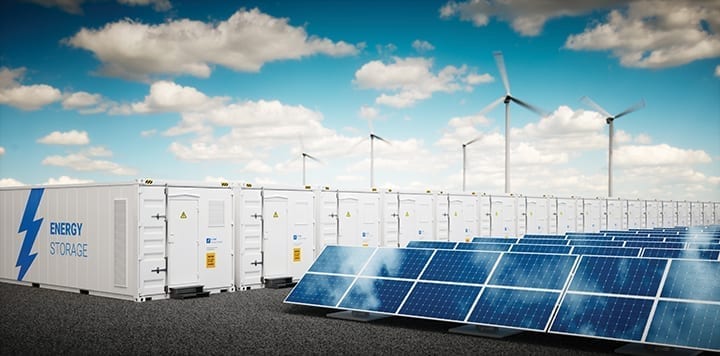
The perfect storm of crises and policy directives have converged to create the energy storage moment. Between the drive to reduce carbon output to “net zero” over the coming decades and the commodity crisis created by the conflict in Ukraine (including its impact on the supply and price of oil and natural gas), the pressure to deploy renewable resources has never been greater.
The term “renewable resources” could include wood or falling water, but policymakers tend to equate “renewable” with wind or solar generation. While wind and solar both produce electricity without carbon emissions and with zero fuel cost, standing alone, they are considered intermittent resources. Put simply, when the wind is not blowing or the sun is not shining, these resources do not produce electricity.
The Challenge of Intermittent Resources
The bulk power system, which powers our nation and enables modern civilization, relies on a continuous current, or uninterrupted flow of electrons, to quite literally “keep the lights on.” For decades, this problem was met through the use of baseload resources such as coal, nuclear, or natural gas, which runs continuously for long periods of time, generating a constant flow of electrons. As tens of thousands of megawatts of these resources seemingly retire each year, they are replaced with intermittent resources like wind and solar.
While batteries and other forms of energy storage have been around for a long time, and according to some theorists, thousands of years (see The Baghdad Battery controversy), widespread deployment of battery storage is a relatively recent phenomenon due to the historic problem of scaling up traditional batteries. With the growth of lithium-ion technology and other competing chemistries (such as iron flow, zinc air, and more), and tremendous demand, battery deployment has grown exponentially in recent years.
In fact, a recent report from Wood McKenzie shows battery storage deployment growth from approximately 257 MW in 2016 to 3,508 MW in 2021, a 1,263% growth rate over that five-year period. That same report shows explosive growth in battery storage continuing over the next several years.
Why Battery Storage Is the Answer
Grid-scale batteries work the same way as those used on a micro level in consumer products, but on a much larger scale. Electric energy is stored in the battery and then released when needed. For wind and solar, batteries can easily provide a solution to the intermittency problem while also taking advantage of market opportunities.
For example, while solar resources generate during the day and are inactive at night, a portion of the output from a solar array can be used to charge the battery, if the battery is deployed alongside the solar array. Then, the energy from the battery can be discharged after the sun goes down. For wind, where the resource typically produces more energy at night, a portion of energy can be diverted to charging the battery and then released from the battery during the day.
In cases where the storage device is not co-located with wind or solar, the economics still work well, as the battery can be charged with cheaper off-peak (overnight) energy and then released during periods of high demand, allowing for the resource owner to simply earn money based on the pricing differential while providing an incredibly valuable peaking service.
While grid-scale batteries can perform a variety of other functions, storage can complement and optimize intermittent resources like wind and solar, providing a cleaner alternative to baseload resources.
—Bill Derasmo is a partner at Troutman Pepper where he represents energy companies before the Federal Energy Regulatory Commission (FERC). He has extensive experience with transmission cost-of-service rates, market-based rates, regional energy market issues, regional transmission planning disputes, seams issues, resource adequacy and capacity market issues, and most recently, energy storage issues. As the energy industry continues to evolve, Derasmo has worked with a variety of clients on unique issues related to the deployment of energy storage, wind and solar resources, and the participation of tax equity.
The post Solving the Intermittency Problem with Battery Storage appeared first on POWER Magazine.